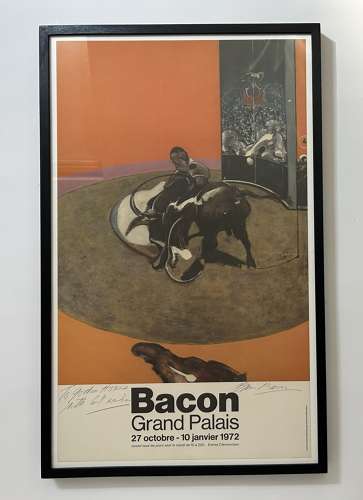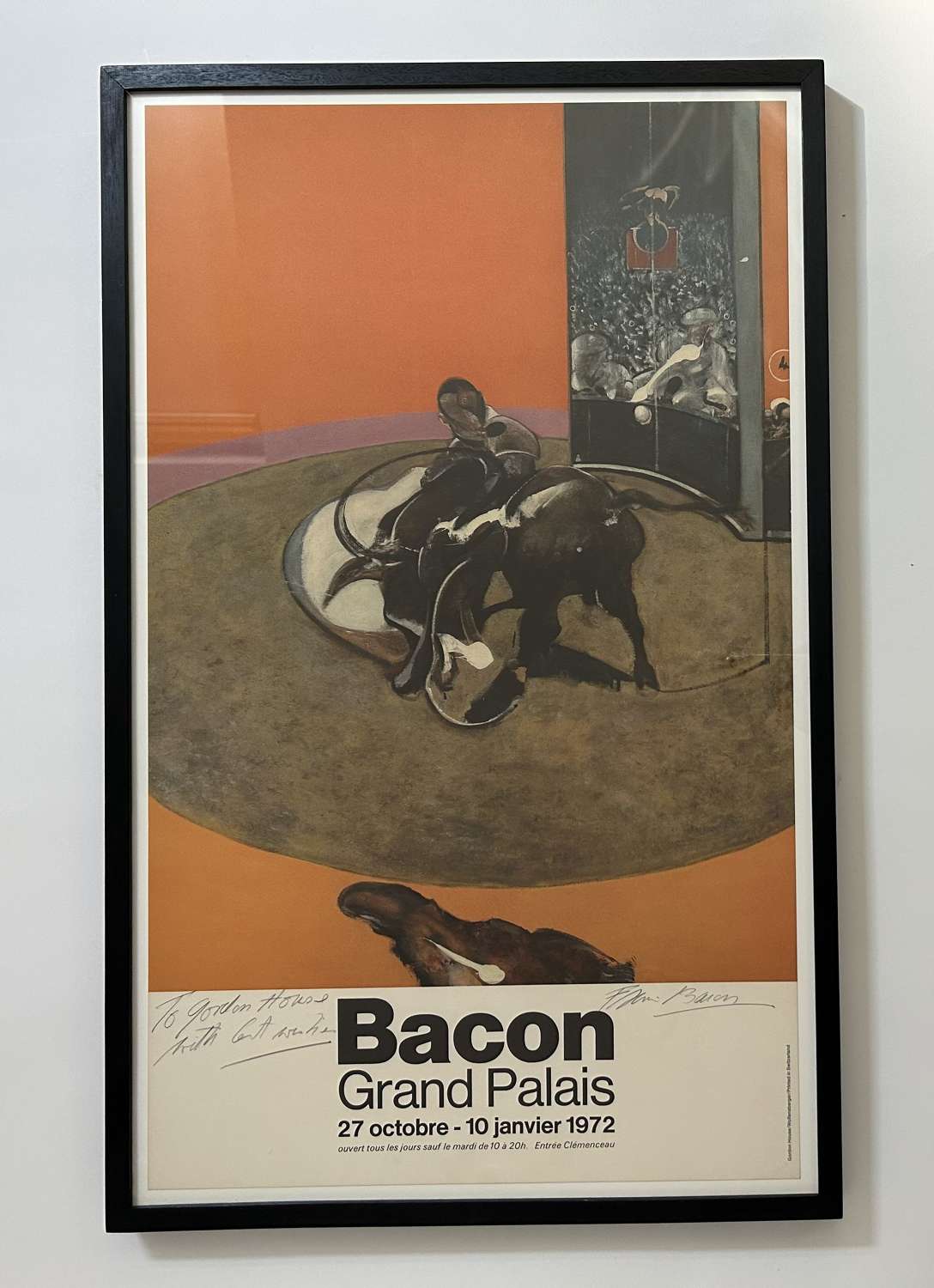
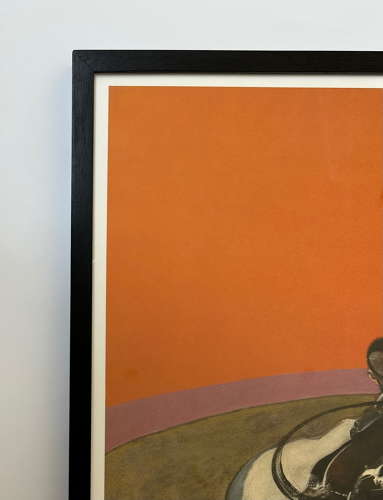
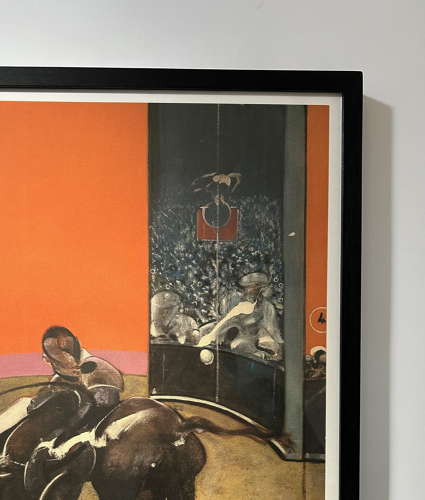
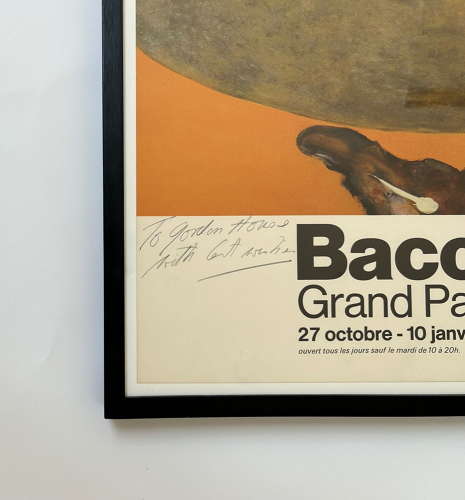
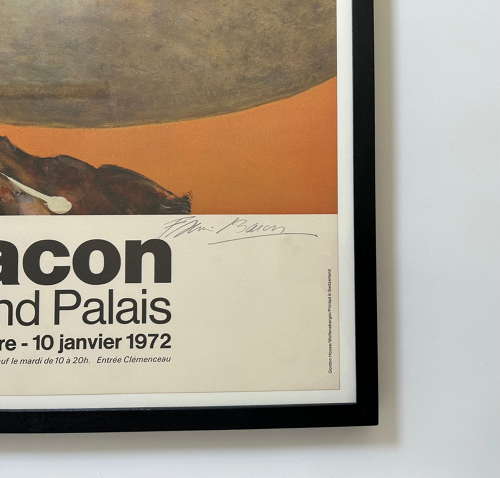
Francis Bacon Signed Grand Palais Poster
Code: 12184
Dimensions:
Francis Bacon Grand Palais Poster inscribed to Gordon, signed by hand.
This is an imprint of the posters published to advertise an extensive retrospect of the works of Francis Bacon in order to launch him on the world stage as one of the greatest artists of the 20 th Century but it also carries a unique associational inscription in the genre of Francis Bacon-signed posters, as Gordon House was the creator of the graphics for the poster.
Gordon House was a personal friend of Bacon’s and was the graphic artist who was responsible for other landmark Bacon exhibitions, especially the now-famous first Russian exhibition of his works in Moscow in 1985.
Gordon House accompanied Bacon and Dyer to the Grand Palais exhibition.
Although Bacon put up a brave front at the Preview of the Grand Palais exhibition, he was almost inconsolable when he discovered Dyer’s tragic ending and it is reported that House was one of Bacon’s inner circle who helped him come to terms with the emotional seismic shock he had suffered immediately before the exhibition that meant a world to him.
It is not an exaggeration to claim that there is no better associational inscription on a Francis Bacon exhibition poster.
The poster was purchased from Gordon House’s son, Ceri House, who had inherited his father’s art collection on his death.
Condition : This vintage framed poster is in a near- fine condition and has been looked after very carefully over the post 50 years as a much-cherished item by its successive owners. It has never been hung or exposed to light.
Dimensions: Frame Size: 77 x 48 cm, Image Size: 71 x 42 cm, Depth of frame: 1.25 cm
Some essential background information on the Francis Bacon inscribed Grand Palais Poster, 1971 :
Francis Bacon, a Francophone and a staunch Francophile was adevotee of French culture in general, as he was of her artistic heritage. For Bacon, the French were the final judges in all field of human activity that interested him. He would throughout his life declare that what mattered to him most was the assessment of his work by the French.
Bacon’s landmark retrospective at the Grand Palais, Paris in October 1971, exhibited one hundred and eight works of his works. This exhibition launched him on the global stage as one of the great artists of the 20 th Century. It also gave him the greatest personal satisfaction compared with any of his previous exhibitions.
At the time Bacon was among the rare living artists to have been granted such an honour, another being Picasso in 1966.
Although the exhibition was a triumph, a true high-point in Bacon’s journey as an artist, on a personal level, a deep tragedy struck him two days before the pre-view of the exhibition, on 24 th October: his companion, lover and muse, George Dyer was found dead at the Hotel des Saints Peres, where they were staying.
George Dyer
From the very beginning, Dyer became devoted to Bacon, admiring his intellect, artistic skills and creations and was in awe of Bacon’s self-confidence. Dyer felt that he had found a purpose in life as the companion and muse of a leading contemporary artist.
But it was a relationship agonisingly dysfunctional, fraught with conflict but infused with love and interspersed with high-octane episodes of alcohol. Dyer was a living Paradox: at one level a gang-affiliated petty criminal of East London and at another, a vulnerable alcoholic craving validation and support who provided Bacon with the unconcealed inspiration for several works of his oeuvre.
Bacon had other muses during his career; he had many other lovers, and always had a wide array of friends and companions but none left such an indelible mark on Bacon’s life and work as George Dyer.
Gordon House
After finishing art school in the early fifties and honing his burgeoning skills in typography and graphic design with a few varied positions of employment, Gordon House set up on his own as a self-employed designer and typographer in 1961.
House designed catalogues and publicity Material for many of the major London galleries of the day, from museums such as the Tate to commercial galleries like Robert Fraser, Marlborough and Eskenazi.
Adopting a simple, modular graphic layout and distinctive style, House turned every gallery into an identifiable entity in the market
place.
House revolutionised the appearance of gallery graphics of the twentieth century and set the benchmark for design now taken for granted as the standard in displays of British art.
